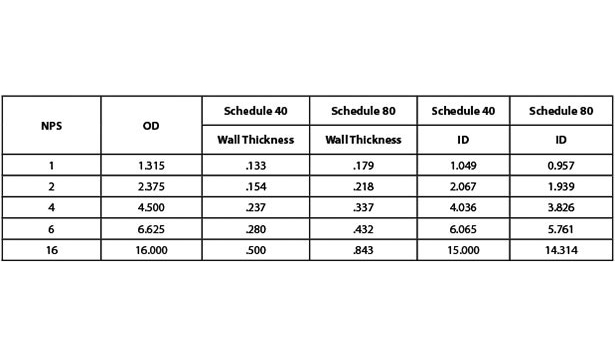Nominal Pipe Size an Important Topic for Drillers of All Types




Within the NPS system, pipe is described by a nominal diameter (NPS designation) and some dimensionless unit that correlates to wall thickness. Most of the confusion that stems from pipe sizing relates to the wall thickness. So let’s start with the simple, slightly less confusing part:
Any given NPS designation will always have the same outside diameter (OD) regardless of wall thickness.
- For NPS 1⁄8 through 12 inches, the NPS designation is smaller than the OD (i.e., NPS 4-inch pipe always has an actual OD of 4.500 inches).
- For NPS 14 inches and up, the NPS designation is equal to the OD (i.e., NPS 16-inch pipe always has an actual OD of 16.000 inches).
So, if the OD is always the same for any NPS designation, the inside diameter (ID) will vary as a function of wall thickness. The main reason pipe people care about wall thickness is because it relates to strength. This led the founding fathers of the NPS system to create dimensionless units that correlate to strength. “Dimensionless” is key, because 4-inch pipe, for example, needs to have thicker walls to meet the same strength standards as 2-inch pipe (see table).
“Schedule” is a historical term that has come to refer to industry standards that tell you how thick the wall is for a certain size of pipe. It is not calculated from any type of formula. The most common schedules we deal with in the environmental industry are 40 and 80. The higher the schedule, the thicker the wall and the stronger the pipe.
In the environmental industry we are familiar with ASTM F480, which standardizes the minimum chemical and physical characteristics of PVC well casing. The actual standard is “ASTM F480 - Thermoplastic Water Well Casing, Pipe and Couplings Made in Standard Dimension Ratios (SDR).” OK, so what the heck is SDR?
“Standard Dimension Ratio” (SDR) is another sizing standard that actually does come from a formula, which is simply:
SDR = (OD)/(wall thickness)
To do some translation: 4-inch, schedule-40 pipe would have a theoretical SDR of 18.987 (4.5/0.237). There is no such thing as 4-inch, SDR-19 pipe; however, you would need calipers to tell the difference between 4-inch, SDR-21 and 4-inch, schedule-40.
Although SDR is logical and much clearer in its origin, “schedule,” being the older more traditional standard, tends to be more commonly used, especially among drillers. Still, plenty of specifications for plastic pipe (PVC and HDPE) do use SDR.
So what does all of this mean? Pipe people may care mostly about strength, but in the drilling industry we also care about what we can fit inside of the casing and screen, so the ID is really important. We can get into trouble if we have small tolerances. For example: Say that some specialized 6-inch tooling is designed to fit just barely inside 6-inch, schedule 40 casing. If someone decides to go with 6-inch, schedule 80 casing due to the depth of the installation, that sampling equipment may not fit anymore. Worse still: It may fit on the way down, but then get stuck down-hole or on the way out.
Some parting shots:
- Even the “actual” dimensions are approximate. Both steel and PVC pipe manufactures have tolerances for ovality; no piece of pipe is perfectly round. So the outside and inside diameters may vary depending on how “out of round” or squished the pipe is.
- Strength is also affected by temperature, which is very important for PVC. The correlation is complicated and depends on the material. However, as anyone who has melted a PVC well will tell you: It matters.
- None of this applies to “tubing” which can look awfully similar to pipe, but isn’t.
Why have we dedicated two months’ worth of columns to this topic? It’s very easy to throw around nice, round numbers when we refer to diameters, but it’s also easy to forget about the actual dimensions of the material or tooling. Most times, those exact dimensions don’t really matter. But when we get complacent about OD, ID wall thickness, schedule and SDR, the consequences can be costly.
David S. Bardsley is business development manager for Directed Technologies Drilling. For more Bardsley columns, visit www.thedriller.com/bardsley.
Looking for a reprint of this article?
From high-res PDFs to custom plaques, order your copy today!










